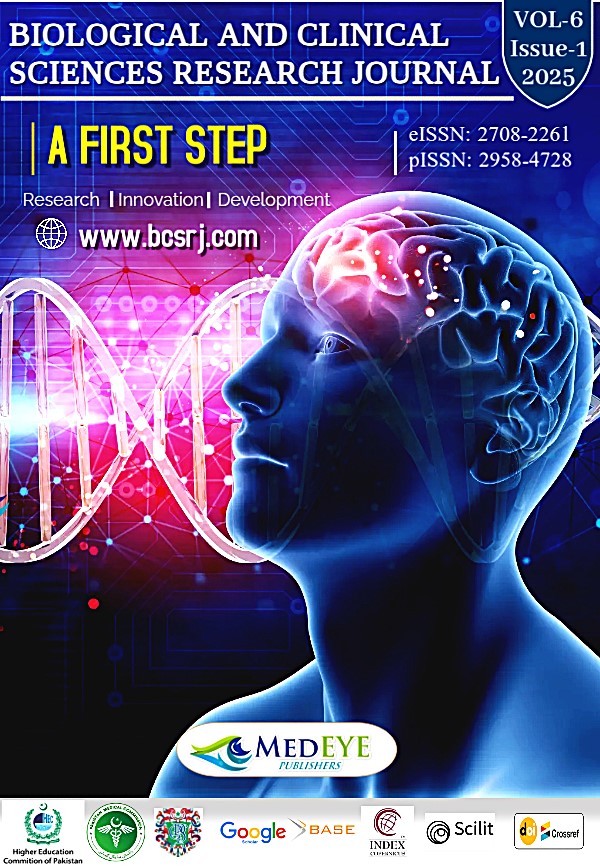Impact of Direct-Acting Antiviral Treatments on Insulin Resistance Reversal in Chronic Hepatitis C Patients
DOI:
https://doi.org/10.54112/bcsrj.v6i1.1537Keywords:
HCV, Hepatic, Hepatitis C, Insulin ResistanceAbstract
Hepatitis C virus (HCV) infection is linked to metabolic complications, including insulin resistance (IR), which can increase the risk of type 2 diabetes mellitus (T2DM), liver fibrosis progression, and cardiovascular diseases. Direct-acting antiviral (DAA) therapy has revolutionized HCV treatment, leading to sustained virologic response (SVR), but its impact on insulin resistance remains under investigation, particularly in HCV genotype three patients. Objective: To assess the effect of direct active antiviral treatment on insulin resistance reversal in hepatitis C genotype three patients achieving sustained virologic response. Methodology: A case-control study was conducted in the Medicine Department of Mayo Hospital from Aug 2024 to November 2024. A total of 100 hepatitis C genotype three patients with advanced liver fibrosis being considered for treatment with DAAs were selected for study. Patients were divided into cases, i.e., 50 patients treated with DAAs, and the control group, i.e., 50 patients left untreated. Blood plasma and serum samples were collected before treatment initiation, after treatment completion, and at 3-month follow-up to check insulin and glucose levels in cases. In the control group, patients were assessed at the start of the study (Time 0) and the 3-month follow-up. Results: Insulin resistance at t0 was 56% vs 58%. HCV clearance was achieved in all patients, and 48 (96%) achieved SVR. Hepatic stiffness in cases was 19.12 ± 9.1 kPa before the start of treatment and 18.84 ± 7.3 after treatment and significantly lower at follow-up (12.45 ± 8.0) (p<0.001). Liver stiffness and steatosis did not change significantly in the control group during the study period. Fasting glucose was 95.59 ± 10.10 mg/dl at baseline, showing significant improvements at follow-up (83.17 ± 12.36). The control group showed no considerable glucose, insulin, or IR variations. A significant association between HOMA-IR and HCV-RNA levels was noted at baseline and a trend was found for hepatic stiffness (p=0.069) and BMI (p=0.060).Conclusion: HCV clearance through direct-acting anti-viral treatment improves or reverses insulin resistance in Hepatitis C genotype III patients, reducing the risk of diabetes mellitus, advanced liver fibrosis, metabolic syndrome, and cardiovascular events.
Downloads
References
Cacoub P, Saadoun D. Extrahepatic manifestations of chronic HCV infection. New England Journal of Medicine. 2021;384(11):1038-1052.
Alzahrani N. Hepatitis C virus, insulin resistance, and diabetes: A review. Microbiology and immunology. 2022;66(10):453-459.
Carvalhal MMdL, Dias JLL, Gomes DL, Quaresma JAS. Hepatitis C virus eradication on glycemic control and insulin resistance. Revista da Associação Médica Brasileira. 2021;67:1821-1824.
Mishra PR, Bharti A, Arora R, Mir IA, Punia V. Increased insulin resistance in hepatitis-C infection—association with altered hepatic function testing. Pathophysiology. 2022;29(3):326-332.
Strauhs-Nitsch L, Campiolo MF, Morsoletto DBG, PISSAIA A, Ivantes CAP. Curing hepatitis C with the new direct acting antivirals did not improve insulin resistance after one year. Arquivos de Gastroenterologia. 2020;57(03):267-271.
El sayed OAE-f, Foda EM, Mohammed AE, El sawy HAMaA. Effect of hepatitis C eradication with DAA on type II diabetes mellitus control as regard insulin resistance & lipid profile. QJM: An International Journal of Medicine. 2021;114(Supplement_1):hcab100. 070.
Mazzaro C, Quartuccio L, Adinolfi LE, Roccatello D, Pozzato G, Nevola R, et al. A review on extrahepatic manifestations of chronic hepatitis C virus infection and the impact of direct-acting antiviral therapy. Viruses. 2021;13(11):2249.
Martinello M, Naggie S, Rockstroh JK, Matthews GV. Direct-acting antiviral therapy for treatment of acute and recent hepatitis C virus infection: a narrative review. Clinical Infectious Diseases. 2023;77(Supplement_3):S238-S244.
Adinolfi LE, Nevola R, Guerrera B, D'Alterio G, Marrone A, Giordano M, et al. Hepatitis C virus clearance by direct‐acting antiviral treatments and impact on insulin resistance in chronic hepatitis C patients. Journal of gastroenterology and hepatology. 2018;33(7):1379-1382.
Hydrie MZI, Basit A, Fawwad A, Ahmedani MY, Shera AS, Hussain A. Detecting insulin resistance in Pakistani subjects by fasting blood samples. Open Diabetes J. 2012;5(1):20-24.
Russo FP, Zanetto A, Gambato M, Bortoluzzi I, Al Zoairy R, Franceschet E, et al. Hepatitis C virus eradication with direct‐acting antiviral improves insulin resistance. Journal of viral hepatitis. 2020;27(2):188-194.
Rey E, Ampuero J, Molina‐Jiménez F, Marañón P, García‐García Y, Múñoz‐Hernández R, et al. Sofosbuvir improves HCV‐induced insulin resistance by blocking IRS1 degradation. Clinical and Translational Medicine. 2021;11(1).
Yosef T, Ibrahim WA, El-Ghandour A, Attia S, El-Nakeep S. Effect of different direct-acting antiviral regimens for treatment of nondiabetic hepatitis C virus–infected Egyptian patients on insulin resistance and sensitivity. The Egyptian Journal of Internal Medicine. 2021;33:1-14.
Janjua NZ, Wong S, Darvishian M, Butt ZA, Yu A, Binka M, et al. The impact of SVR from direct‐acting antiviral‐and interferon‐based treatments for HCV on hepatocellular carcinoma risk. Journal of viral hepatitis. 2020;27(8):781-793.
Tahata Y, Sakamori R, Urabe A, Yamada R, Ohkawa K, Hiramatsu N, et al. Clinical outcomes of direct‐acting antiviral treatments for patients with hepatitis C after hepatocellular carcinoma are equivalent to interferon treatment. Hepatology Research. 2020;50(10):1118-1127.
Adinolfi LE, Petta S, Fracanzani AL, Nevola R, Coppola C, Narciso V, et al. Reduced incidence of type 2 diabetes in patients with chronic hepatitis C virus infection cleared by direct‐acting antiviral therapy: a prospective study. Diabetes, Obesity and Metabolism. 2020;22(12):2408-2416.
Ciancio A, Ribaldone DG, Dotta A, Giordanino C, Sacco M, Fagoonee S, et al. Long‐term follow‐up of diabetic and non‐diabetic patients with chronic hepatitis C successfully treated with direct‐acting antiviral agents. Liver international. 2021;41(2):276-287.
Mada PK, Malus ME, Parvathaneni A, Chen B, Castano G, Adley S, et al. Impact of treatment with direct acting antiviral drugs on glycemic control in patients with hepatitis C and diabetes mellitus. International Journal of Hepatology. 2020;2020(1):6438753.
Ribaldone DG, Sacco M, Saracco GM. The effect of viral clearance achieved by direct-acting antiviral agents on hepatitis C virus positive patients with type 2 diabetes mellitus: a word of caution after the initial enthusiasm. Journal of clinical medicine. 2020;9(2):563.
Downloads
Published
How to Cite
Issue
Section
License
Copyright (c) 2025 Muhammad Zubair, Najaf Ali Pasha, Hashmatullah Khan, Khawar Rafique, Muhammad Ahmad Rao, Zohaib Sadiq

This work is licensed under a Creative Commons Attribution-NonCommercial 4.0 International License.








